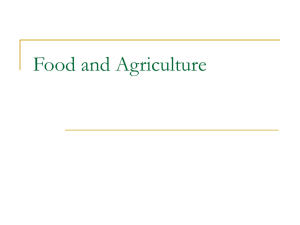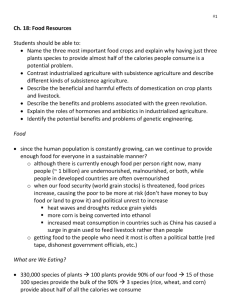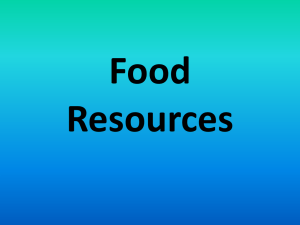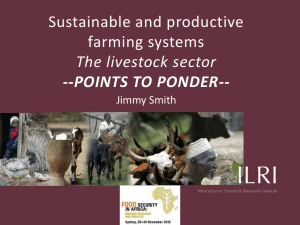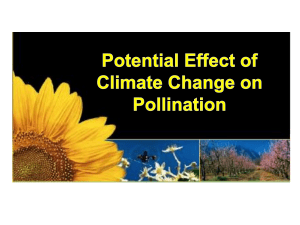agriculture notes ppt - CarrollEnvironmentalScience
advertisement
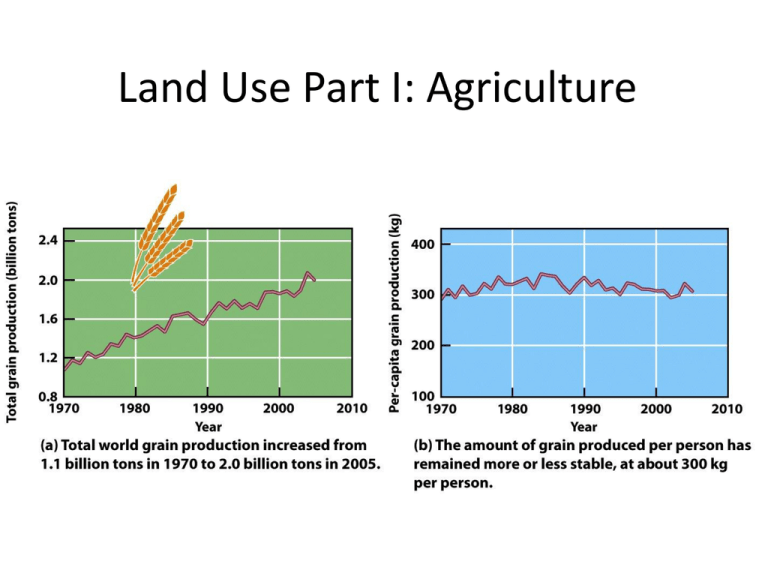
Land Use Part I: Agriculture Food and Nutrition • Foods humans eat are composed of several major types of biological molecules necessary to maintain health : • Carbohydrates – Sugars and starches metabolized by cellular respiration to produce energy • Proteins – Large, complex molecules composed of amino acids that perform critical roles in body • Lipids – Include fats and oils and are metabolized by cellular respiration to produce energy • Vitamins and Minerals Agricultural Land Use • Agriculture now covers more of Earth’s surface than forests. – 38% of planet’s land surface is used for agriculture • 26% pasture/rangeland • 12% cropland Using Land For Agriculture • Humans need: – Most women need ~2,200 kilocalories / day – Men, ~ 2,900 kilocalories / day • Biologists estimate that there are roughly 30,000 plant species with parts that humans can eat • Majority of our food supply (90%) is derived from only 15 plant and 8 animal species • Three grains, wheat, rice, and corn, provide almost half of the calories consumed by people – These three species are all annual plants • 2 out of 3 people on Earth survive primarily on grains • World food supplies have more than kept up with human population growth over the past two centuries. – During the past 40 years, population growth has averaged 1.7% per year, while food production increased an average 2.2%. Chronic Hunger and Malnutrition • Chronic undernutrition – Occurs when people cannot grow or buy enough food to adequately nourish themselves – Consequences: • Mental retardation, stunted growth, increased susceptibility to infectious diseases • Malnutrition – Occurs from low-protein diets that are common in countries where subsistence farming is the most common method of food production • Nearly 6 million children die prematurely each year from undernutrition, malnutrition, and their effects. Hunger Around the World Principle Types of Agriculture • There are two Principle Types of Agriculture 1. Traditional Agriculture – Low Input Polyculture • Human and animal labor used to produce only enough food for farming family’s survival 2. Industrialized agriculture High Input Monocultures – Produce huge output of single crops (monocultures) or livestock (which are often fed monoculture products) Traditional Agriculture: Low Input Polyculture • Many farmers in developing countries use low-input agriculture to grow a variety of crops on each plot of land (interplanting) through: – Polyvarietal cultivation • Planting several genetic varieties. – Intercropping/Polyculture • Two or more different crops grown at the same time in a plot. Polyculture Agriculture • Advantages of polyculture: – Crops mature and ready to harvest at different times – Provides food throughout the year – Soil constantly covered, preventing erosion – Less need for fertilizer and water because roots are at different depths, using more of soil and increasing efficiency – Creates habitats for natural predators of pest species, reducing need for pesticides and herbicides Industrial Food Production: High Input Monocultures • Requires large amounts of energy, water, fertilizers, antibiotics, and pesticides; three of which come from fossil fuels • Produce huge output of single crops (monocultures) or livestock (which are often fed monoculture products) • Accounts for roughly 25% of the world’s cropland • Mostly in developed countries, but it is spreading into developing nations Industrialized Food Production in the United States • The U.S. uses industrialized agriculture to produce about 17% of the world’s grain. – Relies on cheap energy to run machinery, process food, produce commercial fertilizer and pesticides. • About 10 units of nonrenewable fossil fuel energy are needed to put 1 unit of food energy on the table. • Industrialized agriculture uses about 17% of all commercial energy in the U.S. and food travels an average 2,400 kilometers from farm to plate. Sources of Protein -- Livestock • One of the principal uses of animals in agriculture is to transform plant material into high-quality protein • In traditional agriculture, livestock graze land, taking nutrients in and then they defecate and return some of the nutrients to the same field • In industrial agriculture, livestock are fed grains (corn particularly, which they are not “designed” to do) and not necessarily in a field, so the manure does not fertilize a field • Per capita meat consumption has increased 29% between 1950 and 1996 • 1/5th of the world’s population consume roughly half of the world’s grain production through livestock Sources of Protein -- Seafood • Seafood is an important protein source. • Since 1989, 13 of the 17 major fisheries in the world have declined or become commercially unsustainable. • If current practices continue, the world’s fisheries will be exhausted by 2048. • Aquaculture (growing aquatic species in pens) is providing an increasing share of the world’s seafood. Green Revolution • In 1960, 60% of the population of developing countries was considered chronically undernourished. – Fallen to less than 14% today • Due to major improvements in farm production which came from technological advances and modification of a few well-known species. – Corn yields jumped from 25 bushels per acre to 130 per acre in last century. • Most of gain accomplished through conventional plant breeding • Green Revolution started by Norm Borlaug. – Promoted the use of dwarf, high yielding wheat and rice grown around the world. – Do require fertilizers and protection from pests. – Borlaug won Nobel Peace Prize.
